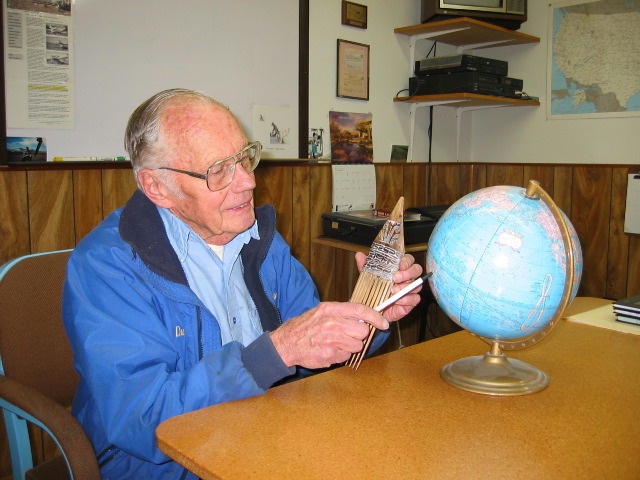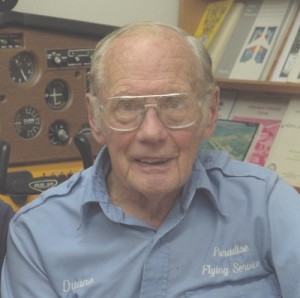I tried phoning Duane Hodgkinson last year, in the summer or early fall as I remember; nobody answered. I have just learned that he passed away on September 19. He will be missed.
His sighting in New Guinea in 1944 (before these islands became the independent nation of Papua New Guinea) deserve attention. Yet I feel we need to see his report in the context of other sightings of large flying creatures in the southwest Pacific. Consider what I now quote from the nonfiction book Searching for Ropens and Finding God, fourth edition:
By telephone and letter, Hodgkinson told me more [about his sighting]. . . . while the native guide was ahead of them on the trail, he and his friend stopped in a clearing. The two soldiers heard a “crashing” noise in the brush, and when they looked toward the uphill side of the clearing they saw the creature take off into the air. Before this takeoff, it was unseen. A wild pig, which had caused the noise, then ran to the downhill side of the clearing, into the taller brush; apparently, it had startled the “pterodactyl,” which then circled above the clearing. [page 25 of SFRFG]
. . . [Duane Hodgkinson] revealed that he had noticed no detail of the long tail he had seen, but the tail was indeed long. [in 2005, in an interview, he revealed his rough estimate for tail length: “at least ten or fifteen feet”] . . . The creature, which Hodgkinson first assumed was a bird, flew up from the edge of the clearing and, as it circled, fifty to one hundred feet above the men, presented a “perfect side view” of itself—obviously no bird. [page 26]
Sighting in Perth, Australia
(Continued quoting of the nonfiction book on ropens)
Soon after I had questioned Hodgkinson, an Australian lady told me about a flying creature she and her husband . . . had observed near the coast of Perth. . . . [top of page 31]
Soon after the sighting, the lady was open about it and tried to spread the news, but people accused her of dishonesty, people who did not know her, so she kept quiet about it for years. When she realized my work was serious, she replied . . . “Whatever people may think, the fact remains that my husband and I both saw that creature. My husband, being a scientist, took in things from the sighting that I [did not] take in.”
I requested her husband’s account and he soon replied: [page 32]
“As I am to understand that my wife has been corresponding with you concerning a certain sighting we witnessed near the coast of the Indian Ocean in Perth, Western Australia, she has encouraged and prevailed upon me to add my perspectives . . .
“We had been walking in the evening and had just crested a hill and were on the down slope along a major thoroughfare. In the distance, I perceived an object in the sky. . . .
“Soon I was able to determine that it was some sort of flying creature, and my first thought was that it must be some very large bird. I was very new to the area at the time and unfamiliar with the native creatures . . .
“. . . its progress had brought it closer and while its shape did resemble a bird, I thought by now that from its apparent distance, it must be the largest bird I had ever witnessed. . . .
“Within a minute or so it had reached our position and was about 250 or 300 feet above us and slightly inland. The area was moderately well lit and I saw that it seemed to be a light reddish-tan color. It did not appear to be covered with feathers but had a leathery texture.
“Soon after it passed us, it flew over a more brightly lit sports area which highlighted even more the leathery appearance, also bringing more detail to view. The wings were the most definite leathery feature. They were shaped in a triangular arch, similar to a very elongated shark fin.” [This man estimated the wingspan of the strange flying creature at 30-50 feet.]
Ropen sighting by seven natives of Umboi Island
We rested while someone went for Gideon. These curious villagers rarely see a Western visitor: probably their first encounter with a ropen hunter. [page 74 of SFRFG]
Gideon arrived . . . the same Gideon I saw and heard in Paul Nation’s video . . .
[Question by Whitcomb] “You told them about when you went up to the mountain where there was a lake . . .”
Gideon nodded many times.
[Whitcomb] “All right. . . What lake was that?”
He appeared surprised at my ignorance and said, “Pung.”
[Whitcomb] “Did you notice . . . did it have wings?”
With a smile, Gideon said, “Yeah.”
[Whitcomb] “It had wings. OK. About how large were the wings . . .”
Gideon said, “Sefan meeta.” . . . [seven meters is about 23 feet]
[Whitcomb] “OK. Did it have a tail?”
“Yeah.”
[Whitcomb] “It had a tail. OK. How long was the tail?”
Gideon looked at the ground to his left for five seconds; from the way he glanced back and forth at the ground a few times, I concluded that he was imagining the tail and estimating its length. He looked back at me and said:
“Sefan meeta long.”
“Seven meters?”
“Yeah.”
One year later, I would analyze this interview and realize the weakness of trying to communicate with villagers about “wingspan.” . . . Gideon meant that one wing by itself was seven meters long.
When I asked about feathers, he gave me the puzzled look.
[Gideon] “There’s no feathers.”
.
Eyewitness of a ropen: Duane Hodgkinson
Other ropen eyewitnesses could be mentioned, but these two from western Australia and this native from Umboi Island support the testimony of Mr. Hodgkinson. The ropen is a real flying creature, seen by natives and Australians and Americans, on occasion, in the Southwest Pacific.
###
.
Within the past twelve years or so, the testimony of Mr. Hodgkinson has been vindicated by reports from other eyewitnesses in the southwest Pacific, many others.
“Pterodactyl” reported alive in Papua New Guinea
A study by an American cryptozoologist suggests that the “pterodactyl” described by the World War II veteran Duane Hodgkinson was a real creature, of a species living in coastal areas of Papua New Guinea.
We do not yet have enough eyewitness reports to determine variations of species of the long-tailed featherless flying creatures that we call “ropen.” The Perth creature may be a different species than the ones observed by Duane Hodgkinson (1944) and by Gideon Koro (~1994), based upon the apparent differences in rations between wingspan and length of tail.
A different kind of attack has been launched, as an American paleontologist has dismissed the ropen as a “fake” pterosaur and dismissed me, Jonathan Whitcomb, as one who practices deception. [A reply to accusations]
.




